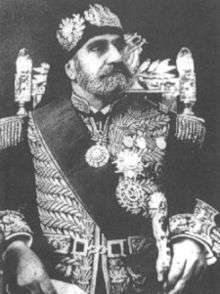Ahmad II of Tunis
Ahmad II ibn Ali (13 April 1862 – 19 June 1942) (Arabic: أحمد باي بن علي باي, ʾAḥmad Bāy bin ʿAlī Bāy), commonly known as Ahmed Bey, was the ruler of Tunisia from 11 February 1929 until his death. He was the son of Ali Muddat ibn al-Husayn.
| Ahmad II | |
|---|---|
 | |
| Bey of Tunis | |
| Reign | 1929 – 1942 |
| Predecessor | Muhammad VI al-Habib |
| Successor | Muhammad VII al-Munsif |
| Born | 13 April 1862 |
| Died | 19 June 1942 |
| Dynasty | Husainides |
| Religion | islam |
He was born in the Dar al-Taj Palace at La Marsa. On 14 January 1928 he became the Bey al-Mahalla (crown prince) of Tunis, and thus the lieutenant-general of the Beylical Army, and became bey upon the death of his cousin Muhammad VI al-Habib.
International Eucharistic Congress
A year after his accession, in May 1930, an International Eucharistic Congress was convened in Carthage to celebrate the centenary of the French conquest of Algeria. It was the first such congress held in Africa, and the first in a Muslim-majority country. Ahmed Bey reluctantly agreed to serve as Honorary President of the Congress, which was partly paid for with 2 million francs worth of funds from the Tunisian government, raised in taxes on Tunisia's Muslim population. The event, with some participants dressed as Crusaders and others using it as a platform for speeches hostile to Islam, caused a furore in the Tunisian national movement. The nationalist newspaper La Voix du Tunisien ('The Tunisian Voice') called on the Bey to resign his Honorary Presidency and for other officials to dissociate themselves from the event and members of the Destour Party claimed that the Bey's involvement demonstrated his subservience to the French and abandonment of the defence of his people's interests.[1][2]
Vichy and the Jews of Tunisia
In 1940 the new Vichy regime in France led to the appointment of a new Resident General, Admiral Jean-Pierre Esteva who began pressing Ahmed Bey to implement Vichy anti-Jewish legislation.[3] Article 9 of the French law of 3 October 1940 decreed that the anti-Jewish laws were applicable in the protectorate territories of the French Republic, including Tunisia.[4]
The Bey made very limited efforts to resist these demands,[5] but eventually signed a decree on 3 October 1940, which excluded Jews from the civil service and from professional roles connected to press, radio, theatre and cinema, while also allowing the publication of a 'Journal israélite de Tunisie' (Jewish Newspaper of Tunisia').[6]
He also imposed a numerus clausus on the liberal professions, although it was never put into effect in some fields, including medicine, where instead Jews were forbidden from treating anyone other than other Jews.[7]
Ahmed Bey signed another decree on 5 June 1941 dissolving Jewish youth groups, and a further one on 29 September 1941 dissolving the Jewish Community Council in Tunis and replacing it with an appointed body.[8] His decree of 26 June 1941 ordered a census of the Jews.[9]
Rise of nationalism
In the period of Ahmad's reign, the nationalist movement grew in political importance. The burials issue was particularly contentious, and the Neo Destour party was formed after the Ksar Hellal Congress in 1934.[10]
Death and succession
Ahmad died at La Marsa and was buried at the Tourbet el Bey. He was succeeded by his cousin Muhammad VII al-Munsif.
Ahmad II had ten sons and eight daughters, including Prince Muhammad al-Taib Bey (1902–1989) who was the head of the Husainid Dynasty from 1974 until 1989.
References
- David Motadel, Islam and the European Empires OUP 2014 p.90
- Kenneth Perkins, A History of Modern Tunisia, Cambridge University Press, 2014 p.96
- http://www.shjt.fr/wp-content/uploads/2010/11/Les-Juifs-de-Tunisie-face-%C3%A0-Vichy-et-aux-pers%C3%A9cutions-allemandes.pdf Archived 11 August 2017 at the Wayback Machine p.206 accessed 2/5/2017
- https://fr.wikisource.org/wiki/Loi_du_3_octobre_1940_portant_statut_des_Juifs
- Archived 5 October 2008 at the Wayback Machine Abdelaziz Barrouhi, 'Moncef Bey, les juifs, l’Axe et les Alliés', Jeune Afrique, 13 August 2006 [archive]accessed 2/5/2017
- Paul Sebag, Histoire des Juifs de Tunisie : des origines à nos jours, éd. L’Harmattan, Paris, 1991 p.225
- Paul Sebag, Histoire des Juifs de Tunisie : des origines à nos jours, éd. L’Harmattan, Paris, 1991 pp. 222–227
- Paul Sebag, Histoire des Juifs de Tunisie : des origines à nos jours, éd. L’Harmattan, Paris, 1991 p.230
- [PDF] http://www.shjt.fr/wp-content/uploads/2010/11/Les-Juifs-de-Tunisie-face-%C3%A0-Vichy-et-aux-pers%C3%A9cutions-allemandes.pdf Archived 11 August 2017 at the Wayback Machine p.211 accessed 2:5/2017
- Kenneth Perkins, A History of Modern Tunisia Cambridge University Press 2004 p.79
External links
- video clip of Ahmad Bey welcoming the French President on his visit to Tunisia
- video clip of Ahmad Bey's funeral
| Preceded by Muhammad VI al-Habib |
Bey of Tunis 1929–1942 |
Succeeded by Muhammad VII al-Munsif |